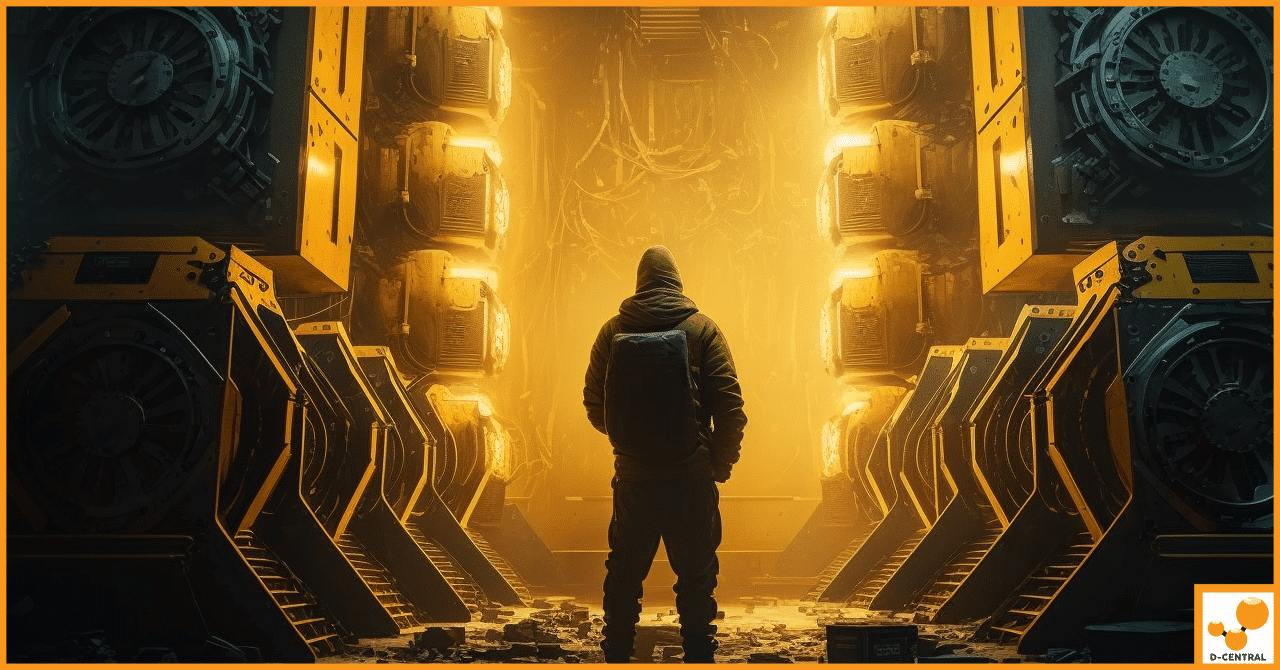
Harnessing Wasted Energy: How U.S. Natural Gas Flaring Could Power Millions of Bitcoin Miners
In recent years, the energy sector in the U.S. has been under scrutiny, not just for its contribution to global
4479 Desserte Nord Autoroute 440, Laval, QC H7P 6E2

Are you an ASIC miner wondering if you should repair or replace your machine? If so, then the 50 Percent Rule is something you need to be aware of. This rule states that if the cost of repairs for your ASIC miner exceeds fifty percent of the cost of replacing it with a new one, it’s time to switch out the old for some shiny new hardware. But other factors come into play when deciding whether to repair or replace an ASIC miner. In this blog post, we will explore these additional considerations and how they impact the decision-making process.
When it comes to ASIC miner repairs, the 50 Percent Rule is a helpful guideline to determine whether repairing or replacing the miner is the more cost-effective option. The rule states that if the cost of repairs exceeds 50 percent of the cost of purchasing a new ASIC miner, then it is more cost-effective to replace the miner instead of repairing it. This rule takes into account both the cost of repairs and the current market conditions for Bitcoin.
To effectively use this rule, miners must assess several factors. In addition to the cost of materials and labour associated with repairs, miners should also consider the age of their hardware, their ability to obtain replacement parts, and the likelihood of being able to resell any additional hardware they may acquire. Assessing all relevant factors can help miners make an informed decision about whether to repair or replace their ASIC miner.
Miners should also consider market conditions when deciding whether to repair their ASIC miner. If market prices are low at the time of purchase or during a period in which prices remain stagnant, then it is unlikely that investing in a new machine would yield any return on investment. On the other hand, if Bitcoin prices are high and expected to rise further in the future, then replacing the current ASIC miner could yield higher profits than repairing it.
Exceptions to the 50 Percent Rule may be made in certain situations. For example, if the miner is outdated and there are no available replacements, then repairs can often be more cost-effective than replacing them. Additionally, suppose the miner has sentimental value or historical significance, such as being the first ASIC ever used by a particular mining operation. In that case, repairs may also be a more viable option. Furthermore, if sources of supply for replacement parts are limited or unavailable, repairs may be the only realistic option.
In addition to cost considerations, other factors should be considered when considering whether to repair or replace your ASIC miner. These factors include the age and condition of your miner, as well as its expected life span after repairs are completed. The miner’s current hashrate, power consumption efficiency and ability to run newer algorithms should also be considered. Finally, our miner’s availability of parts, mining difficulty and cost of electricity should also be considered before making a decision. Ultimately, choosing between repairing or replacing depends on which option will be more cost-effective in the long run.
Following the 50 Percent Rule when deciding whether to repair or replace an ASIC miner can provide many benefits. By making a more cost-effective decision in the long run, miners can avoid wasting money on repairs that will not extend the life of their miner. Additionally, having up-to-date equipment can help miners get the most out of their mining operations and increase profits. Furthermore, following the 50 Percent Rule helps to ensure that miners are informed and have made a sensible decision regarding their mining operations. This peace of mind is invaluable for any miner who wants to generate maximum returns from their investments.
Market fluctuations in the crypto industry can have a significant impact on the cost of repairs for ASIC miners. When Bitcoin prices are high, repair costs may increase due to the surge in demand for parts and labour. This can leave miners struggling to keep up with the expenses associated with their equipment maintenance. In some cases, miners may even find themselves forced to choose between repairing or replacing their ASICs depending on which option is more cost-effective.
The difficulty of mining also affects repair costs. As the difficulty of mining increases, older models that don’t offer competitive hash rates become increasingly less profitable. Consequently, miners who want to stay competitive must upgrade their hardware or risk being left behind. This causes repair costs to surge as they look towards purchasing new parts and labour to replace their older models.
At the same time, high Bitcoin prices can make it difficult for small time buyers to purchase new rigs due to market saturation from large scale investors and profiteers taking advantage of the situation. This further fuels demand for repairs as more and more people look for ways to maximize their profits by keeping their existing ASICs running at optimal performance levels.
When Bitcoin prices drop however, it can be a different story altogether. Lower prices generally mean lower repair costs as demand decreases since fewer people are looking to upgrade or maintain their hardware. At these times, miners may be able to take advantage of lower labour costs as well as cheaper replacement parts if they need them.
In addition, when Bitcoin prices fall, miners may also find that they have additional funds available to invest in upgrades or replacements if needed without breaking the bank. This gives them greater flexibility when making decisions about maintenance and upgrades versus simply relying on repairs out of necessity due to lack of funds available for new purchases.
Overall, market fluctuations play an important role in determining whether repairing or replacing an ASIC miner is better in terms of cost-effectiveness and overall profitability for miners running ASICs.
Evaluating the overall condition of an ASIC miner is an essential step in determining whether to repair or replace it. The condition of the miner can be assessed by looking at various factors such as wear and tear, corrosion, and vibration damage. A miner that has been in use for a long time may have worn out components that need to be replaced, such as fans or power supplies. Additionally, corrosion can occur due to high humidity or exposure to corrosive chemicals, which can cause damage to the miner’s electronic components. Vibrations can also cause damage, particularly to mechanical parts like fans, and can affect the performance of the miner. By carefully evaluating the overall condition of the ASIC miner, you can determine whether repairing it is a viable option or whether it would be more cost-effective to replace it with a newer model.
Factors to Consider when Deciding Whether to Repair or Replace Your ASIC Miner
When deciding whether to repair or replace your ASIC miner, there are a few important factors to consider. First, you should look at the service history of the miner to assess its reliability and identify any previous issues that may indicate future problems. Additionally, evaluate the miner’s performance, hash rate, power consumption, cooling system, and other factors that can influence productivity in order to make an informed decision. Furthermore, it is important to consider the wear and tear, corrosion damage, vibration damage, or any other potential causes of malfunction when determining if repairs or replacement is best.
In addition to assessing the physical characteristics of the miner itself, it is also important to consider how vital it is to your mining operations as well as the risks associated with downtime due to repairs or replacements. Moreover, long-term costs associated with running the ASIC miner such as electricity and maintenance costs should be considered when making this decision. Furthermore, you should factor in how much downtime would occur due to repairs or waiting for new equipment and how it may affect productivity levels and quality control processes within your mining operations. Finally, make sure to factor in indirect costs such as health, safety and environmental costs that may result from unscheduled downtime due to unexpected repairs or replacements when deciding if repairing or replacing is the best option.
When considering whether to repair or replace an ASIC miner, age is a key factor that should be taken into account. Technology advances quickly and more powerful miners are being introduced all of the time, so if you have an old model that has been in use for a long period of time then chances are it is not as efficient or profitable as newer models on the market. This can be due to its outdated algorithms, slower hash rate or higher power consumption compared to newer models. Therefore, when deciding between repairing your existing miner or upgrading/ replacing with a newer model altogether, it’s important to consider both short-term costs such as labour and replacement parts versus long-term profits from mining operations.
When deciding whether to repair or replace an ASIC miner, one important factor to consider is the availability of parts. If you are unable to find compatible spare parts due to them being discontinued or too expensive, then replacing with a newer model may make more sense financially in the long run even if there were no other issues with your current miner. It can be difficult to source specific spare parts for older models of miners as they become less popular over time and manufacturers often focus on producing new models instead. Additionally, some components may only be available from third-party suppliers meaning that they will usually be more expensive than those purchased directly from the manufacturer. Therefore, before opting for repairs it is worth researching whether or not the required parts are available at a reasonable price.
Mining difficulty is an important factor to consider when deciding whether to repair or replace an ASIC miner. Mining difficulty refers to the amount of computing power required in order to solve complex mathematical equations and receive rewards. As mining difficulty increases, it becomes more difficult for older models of miners that are not as efficient or powerful as newer models to generate profits due to their inability to effectively solve these equations. Therefore, if your existing model cannot keep up with current levels of mining difficulty then it may be worth investing in a more powerful model so that you can remain competitive and profitable even when mining difficulty rises over time.
When it comes to ASIC miners, the cost of electricity is an important factor to consider when determining whether to repair or replace your current model. The more energy-efficient a miner is, the less electricity it will consume and the more profits you can generate from it. Therefore, investing in a newer model could save you money over time since it generally tends to be much more energy-efficient than older models. In addition, some countries have different electricity rates depending on how much power you use which can also affect profitability if not taken into account. Furthermore, taking advantage of renewable sources like wind and solar may enable even greater cost savings associated with operating an ASIC miner, which could increase returns from mining operations in the future.
In conclusion, when considering whether to repair or replace an ASIC miner, it is important to consider both current and future mining difficulties and the cost of electricity. Investing in a newer model could save you money over time since they tend to be much more energy-efficient than older models. Additionally, taking advantage of renewable sources may enable even greater cost savings associated with operating an ASIC miner, enabling higher returns from mining operations in the future. Ultimately, researching all options thoroughly before making any decisions can help ensure that you make the most cost-effective decision for your long-term profitability as a cryptocurrency miner.
What is the 50 Percent Rule for ASIC Repairs?
The 50 Percent Rule is a guideline that helps determine whether it is more cost-effective to repair or replace an ASIC miner. If the cost of repairs exceeds 50 percent of the cost of purchasing a new miner, it is generally recommended to replace the miner instead of repairing it.
What factors should I consider when deciding whether to repair or replace my ASIC miner?
When deciding whether to repair or replace your ASIC miner, you should consider the cost of repairs, the age of the hardware, your ability to obtain replacement parts, market conditions for Bitcoin, and the likelihood of being able to resell any additional hardware acquired.
Are there any exceptions to the 50 Percent Rule?
There are exceptions to the 50 Percent Rule. If the miner is outdated and there are no available replacements, repairs may be more cost-effective. Additionally, if the miner has sentimental or historical significance, repairs may be a viable option. Limited or unavailable sources of replacement parts may also make repairs the only realistic option.
How do market fluctuations impact repair costs for ASIC miners?
Market fluctuations can impact repair costs for ASIC miners. When Bitcoin prices are high, repair costs may increase due to increased demand for parts and labor. Conversely, when Bitcoin prices are low, repair costs may decrease as demand decreases. Market fluctuations can also impact the availability and affordability of replacement parts.
What should I consider when evaluating the overall condition of an ASIC miner?
When evaluating the overall condition of an ASIC miner, factors such as wear and tear, corrosion damage, vibration damage, and component reliability should be considered. Assessing the physical condition of the miner can help determine whether repairs are viable or if replacement is the better option.
What factors should I consider when deciding whether to repair or replace my ASIC miner?
When deciding whether to repair or replace an ASIC miner, you should consider the age of the miner, the availability of replacement parts, mining difficulty, the cost of electricity, the condition of the miner, and any associated risks or costs of downtime.
DISCLAIMER: D-Central Technologies and its associated content, including this blog, do not serve as financial advisors or official investment advisors. The insights and opinions shared here or by any guests featured in our content are provided purely for informational and educational purposes. Such communications should not be interpreted as financial, investment, legal, tax, or any form of specific advice. We are committed to advancing the knowledge and understanding of Bitcoin and its potential impact on society. However, we urge our community to proceed with caution and informed judgment in all related endeavors.
Related Posts

In recent years, the energy sector in the U.S. has been under scrutiny, not just for its contribution to global

In the last decade, the financial world has witnessed a paradigm shift, one that has redefined the very essence of

The landscape of cryptocurrency mining has undergone a remarkable transformation since the inception of Bitcoin in 2009. Initially, enthusiasts could